This English Candy Bar Powered the First Everest Ascent
The story of how a confectionary mishap helped Edmund Hillary and Tenzing Norgay reach the world’s most famous summit
When Edmund Hillary and Tenzing Norgay summited Everest in May 1953, they weren’t fueled by carbohydrate cocktails and fancy gels or advised by a trained sports nutritionist. Instead, they were powered by intuition and an English candy experiment gone wrong.
In 1869, English confectioner Joseph Wiper was trying to make peppermint creams. At one point, he took his eyes off the sugar he was boiling, and it began to granulate and turn an odd opaque color. Wiper let the mush cool and ended up happy with the result. He began selling the “mint cakes” from his hometown of Kendal, on the edge of the British Lake District.
The Kendal Mint Cake is not, in fact, a cake at all. Fudge-like in texture on the outside with a peppermint patty–style filling, it’s more like an enlarged York candy. It’s made from just sugar, water, syrup, and peppermint oil—not exactly a nutritional powerhouse. But it unintentionally became a favorite with local hill walkers and climbers almost as soon as it was put to market in the late 1800s. That’s because when you’re burning straight through calories—as many as 20,000 of them on an Everest summit day—pure energy is exactly what your body wants. Just one of these bars contains about 379 calories of quick-digesting glucose, so they soon became an easy, tasty way to meet those energy needs.
Seven days before Hillary’s group set off for Nepal, one of the mountaineers saw an advertisement for the mint cake in a climbing magazine. He wrote to the confectioner with an urgent request for 38 pounds of the candy—the amount one porter could transport up the mountain by himself. Sweets were still strictly rationed after World War II, so the confectioner and his staff had to pool their ration coupons together to fill the order.
The entire expedition loved it. One member of Hillary’s team wrote that “it was easily the most popular item in our high-altitude ration packs—our only criticism is that we did not have enough of it.” But the Kendal Mint Cake’s appeal boils down to more than just an uncanny ability to satisfy a sweet tooth. Its draw—and its efficacy—has science on its side.
During a high-altitude ascent—defined as 8,000 feet or more above sea level—you have to game your nutrition strategy carefully. There’s less oxygen near the top of Everest, which forces your body to redistribute blood to the brain, heart, and lungs and decrease the amount of blood flowing to the digestive organs.
Less energy and fewer resources in the digestive system make foods that are high in protein and fats hard to digest, and the effort sucks up energy that is needed elsewhere. Easily digestible foods made from simple carbohydrates (sugars) are much easier for your body to process, and the Committee on Military Nutrition Research recommends sticking to a diet high in simple carbs in these settings. Decreased blood flow around the digestive organs typically results in a much lower appetite. But hunger aside, the major ascent still requires a tremendous amount of energy to power the muscles and, on Everest, stay warm. Mountaineers must trick themselves into fueling properly by eating small, calorie-dense snacks to stay healthy and prevent bonking.
Another problem at extreme heights: taste. Adrian Ballinger says that “everything tastes terrible,” so convincing a mountaineer to eat enough can be quite a challenge A study from the Fraunhofer Institute for Building Physics, commissioned by Lufthansa, concluded that dry air is to blame for bad taste. When the air lacks humidity, your nasal passage, mouth, and throat lose their moisture, impairing your sense of smell and taste. At 30,000 feet, our perception of salt drops between 20 and 30 percent, whereas sugar perception dulls by only 15 to 20 percent. That could be why the Kendal Mint Cake, which is basically pure sugar, tastes so good in the death zone.
Since that first 1953 ascent, legendary British mountaineers like Joe Tasker and Sir Chris Bonington have continued to bring Kendal Mint Cakes up Everest. The classic candy is still used by amateur hikers and professional mountaineers. John Barron, managing director at candy-maker Romney’s, says the confection has been to “K2, Kilimanjaro many times…One team even took it about as low as you can possibly go, to some caves in Borneo.” Not a bad legacy for a 19th-century energy bar created by mistake.
How Big Is Too Big for Kickstarter?
You May Also Like

AI in Fashion: Revolutionizing Design, Shopping, and Supply Chains
February 28, 2025
Revolutionizing Fashion: How AI is Redefining Design and Sustainability
March 1, 2025